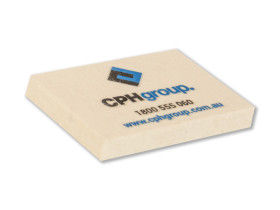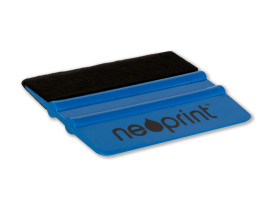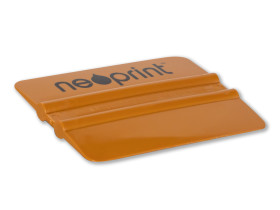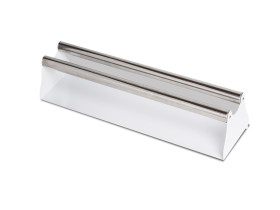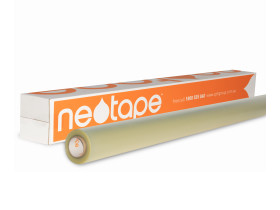Application Tape Tips and Troubleshooting
Here are some tips and techniques to ensure you achieve the best possible results when applying app tape!
Tips and Tricks
Clean the Application Surface
Clean the application surface thoroughly with isopropanol or a similar cleaning solvent. Clean glass twice to remove window cleaner buildup.
A solution of detergent in water (1 drop per 5 litres) will make a suitable application fluid.
Pressure-sensitive vinyl may not stick to car windows treated with water-repellent products (such as silicone polishes) despite the use of cleaning agents. It could take up to six months before such window treatments dissipate enough for vinyl to adhere properly.
Preferred Method to Remove Vinyl Lettering from Liner
1. Flip the graphic over so the taped side is facing down
2. Starting at the top corner, peel the liner backing at a 180º angle
Transferring Vinyl; Wet vs. Dry
Most vinyl graphics are applied to the sign surface dry. However, using the wet application method (most commonly done with paper application tapes) allows the graphics to slide on the application surface for easier placement and repositioning.
Standard-weight paper application tape can withstand being wet only for a short period of time.
If the tape is “over-soaked” or remains wet too long, it will tear, fall apart or leave adhesive residue on the vinyl.
Wet Apply Method with Paper Application Tapes
Application Steps
1. Spray a fine solution mist onto the cleaned application surface OR to the adhesive side of the taped vinyl lettering.
2. “Float” lettering into place on the application surface.
3. Apply firm squeegee pressure from the centre to remove bubbles and wrinkles from under the vinyl.
4. Wait one or two minutes to allow the vinyl to adhere.
5. Firmly squeegee a second time to fix the vinyl permanently.
6. Carefully remove the tape by folding it back over itself at a 180º angle from the top corner. *If the tape does not remove easily from the vinyl, spray a light mist of wet solution on the back side of the tape and wait a few seconds. (This should help release the tape from the vinyl without leaving adhesive residue).
7. It will be necessary to squeegee the vinyl lettering one last time after removing the application tape, particularly the edges. Hold a piece of used liner backing over the vinyl to protect the surface and apply firm squeegee pressure.
8. Pop any bubbles left in the vinyl with a pin.
Troubleshooting
Adhesive Residue on Vinyl When Using Wet Solution:
Are you using too many of the solutions?
It is not necessary to wet both the application surface and the adhesive side of the vinyl. Wet only one of these surfaces with a fine mist. Do not soak.
Are you using plastic application tape?
Unlike paper, plastic is not porous and traps liquid between the lettering and the application surface. This can delay the vinyl’s adhesion to the surface and quickly break down the adhesive’s bond with the plastic tape. Try a paper application tape instead.
Tape Tears or Falls Apart When Using Wet Solution:
* Refer to the first point above. However, if certain jobs require additional wet solution, try using a premium grade paper - The heavier weight paper holds up better and longer.
Vinyl Will Not Stick to the Application Surface:
Try using more squeegee pressure.
After positioning the vinyl to the sign surface, do not remove the application tape for at least 10-15 minutes. The adhesive on pressure-sensitive vinyl increases its bond to surfaces considerably after a short period of time. This will allow it to build stronger adhesion to the sign surface than the tape to the vinyl.
Is the application surface porous, rough, or “non-stick”, such as polyethylene or a latex-painted wall?
Pressure-sensitive vinyl is designed to adhere to smooth, non-porous surfaces. Try the previous suggestion above.
Are you transferring to irregular or riveted surfaces?
Try a rivet brush to burnish the vinyl down into the low spots.
How cold is it?
Pressure-sensitive vinyl may resist sticking immediately to very cold surfaces. Ideally, application environments and surfaces should be at least 10ºC. If this is impossible, try the suggestion in the second point above.
Was the application surface cleaned thoroughly?
If the surface is not cleaned properly, the vinyl will not stick.
Is the vinyl graphic/ lettering larger than 100 millimetres?
Try a medium-tack application tape that should be easier to remove from larger vinyl cuts.
Try wetting the back of the application tape with a fine mist of wet solution and wait one or two minutes before removing it from the vinyl lettering.
How old is the tape or vinyl?
If over one year old, unless otherwise stated by the manufacturer, application tape for vinyl may have reduced adhesiveness.
Vinyl Will Not Lift From Liner Backing:
* Try more squeegee pressure to tape and graphics.
Have you changed the vinyl brand, type or colour?
Sometimes, even a simple change in the colour of the same brand of vinyl can change application tape performance.
How small is the cut lettering or graphic?
Very small, intricate graphics may require a higher tack application tape, such as NT150 or RT4076RLA.
Try leaving the application tape masked to the vinyl for a longer period of time.
Depending on the adhesive, some application tapes increase their adhesion to the vinyl by about 10% over the first twenty-four hours, which may be enough to lift a difficult, small graphic.
Was the graphic cut too deeply?
This could fuse the edge of the vinyl into the liner backing. If so, try wetting the back of the liner with a fine mist of wet solution or a damp sponge, then attempt removal.
Was the application tape exposed to high temperatures and/or humidity?
If so, it could have lost some of its adhesion. Application tape should be stored on end at room temperature. The maximum shelf life of application tapes is generally one year when stored properly. Variations in temperature outside the recommended range could reduce performance results.
Are you using a medium-tack application tape?
If so, try a high tack. If unsure of your current product’s tack level, contact us to discuss which products might best suit your job.
Fine Lettering Won't Release from the Backing Liner and Stick to the Wall:
Try this: When removing the application tape, using two hands, pull the app tape downwards, folding it completely over itself at a 180º angle, and slide the app tape down the wall face.
Instinctively you will grab a corner and pull it downwards and away from the wall at a 90º angle, this is not the way to go!
If you still have trouble getting the application tape to release the lettering, use a wet rag, lightly wrung out, to wipe the app tape down thoroughly.
The adhesive in the app tape is water soluble and the app tape itself is porous. The water will soak through the app tape and start breaking the adhesive while leaving the non-porous lettering unaffected and in place.
You will find the app tape is much more flexible and pliable when wet and will come off relatively easily as you follow the above technique.
If you have any tips or tricks, we'd love to hear them. Send us an email and we'll share your experience with other sign professionals.
